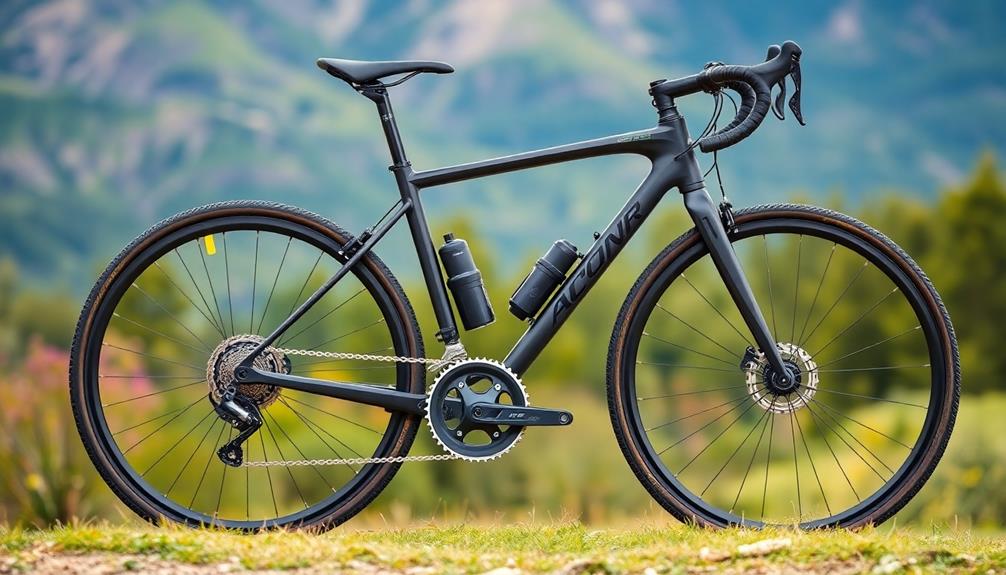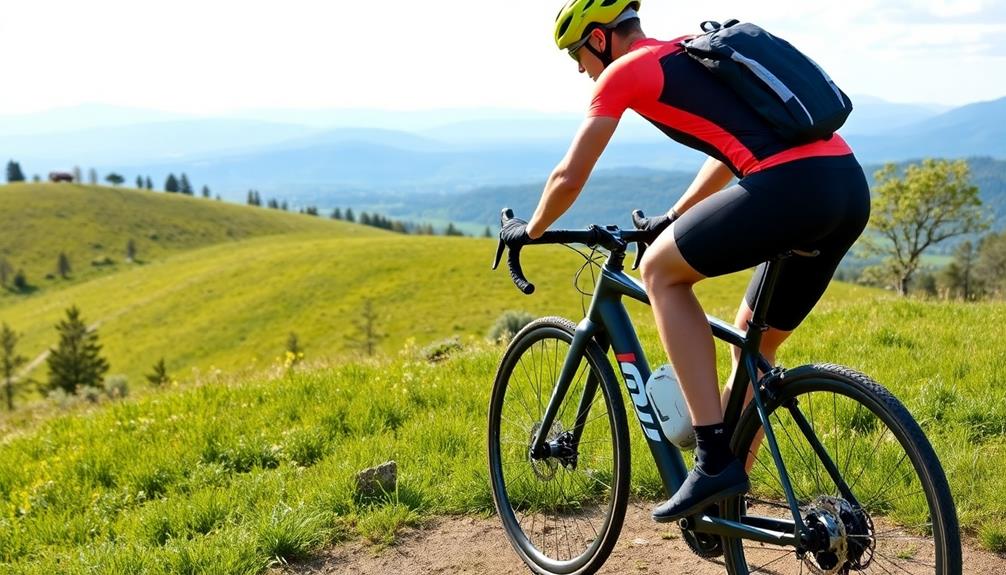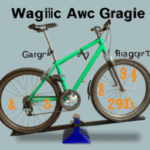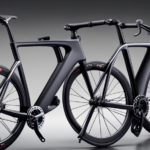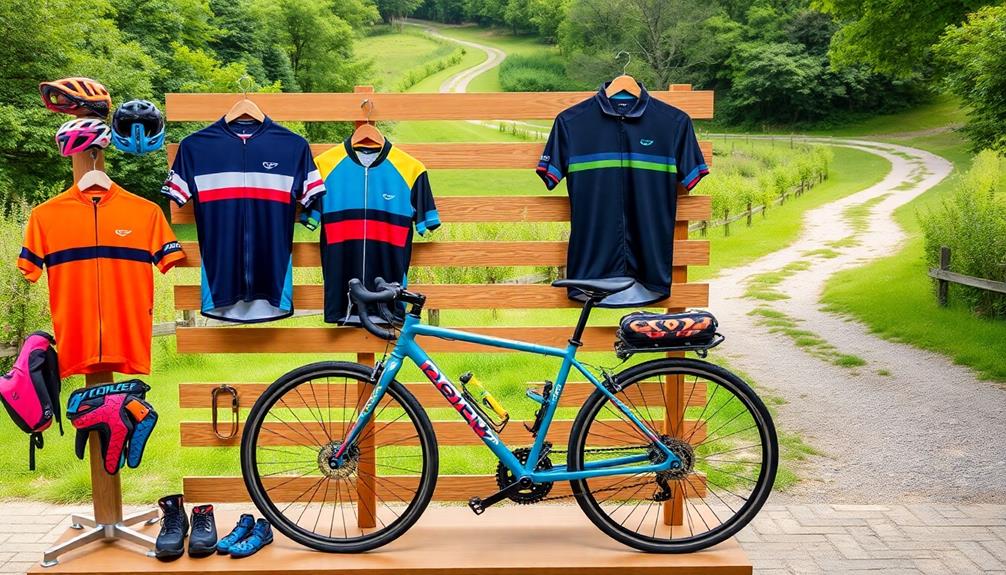To reduce your hybrid bike's weight, start by upgrading to lightweight components, like carbon handlebars and alloy bolts. Switch to lighter tyres, such as those from Continental, and consider latex inner tubes for extra savings. You can also enhance your wheels; lightweight options like Cadex can save significant grams. Trim excess cable lengths and minimize unnecessary accessories to streamline your setup. Regular inspections help you identify and replace heavier parts. Every little change adds up, boosting your bike's performance. You'll discover even more effective strategies to keep your bike light and agile as you explore further.
Key Takeaways
- Upgrade to lightweight components, such as carbon handlebars and titanium bolts, to significantly reduce overall bike weight.
- Switch to lightweight tyres and latex inner tubes to enhance performance and decrease rolling resistance.
- Regularly check and replace worn parts with lighter alternatives for cumulative weight savings.
- Trim excess cable lengths and minimize unnecessary accessories for improved aerodynamics and efficiency.
- Maintain proper tyre pressure and conduct routine inspections to ensure optimal performance and weight management.
Importance of Weight Reduction
When you consider the importance of weight reduction on a hybrid bike, you'll quickly realize its impact on performance. Reducing weight can make a significant difference in how easily you accelerate, climb hills, and maintain higher speeds during your rides.
A lighter bike means less energy is required to pedal, which enhances your endurance and lets you enjoy longer rides with less fatigue. Additionally, incorporating options like an electric bike conversion kit can't only provide added assistance but also allow for a more efficient ride without the burden of excess weight.
Upgrading components like wheels, tires, and handlebars can yield substantial weight savings, sometimes cutting up to 500 grams from your bike's overall weight. By prioritizing lightweight materials, such as carbon fibre for handlebars or opting for tubeless tires, you can achieve a more responsive and agile riding experience.
Regularly evaluating your bike's weight and strategically swapping out heavier components can lead to cumulative savings that enhance both your bike's efficiency and your confidence on various terrains.
This proactive approach not only optimizes your ride but also transforms your cycling experience. So, if you want to maximize your hybrid bike's potential, focusing on weight reduction is a game-changer you shouldn't overlook.
Cockpit Modifications

When you're looking to shed weight in your bike's cockpit, consider your handlebar material choices.
Swapping out alloy handlebars for lightweight carbon fiber can offer significant weight savings and improved handling.
Additionally, opting for a lighter stem like the Kalloy Uno can further enhance your bike's performance without adding bulk.
Handlebar Material Choices
Choosing the right handlebar material can make a significant difference in your hybrid bike's overall weight. If you're looking for effective handlebar material choices, consider swapping your alloy handlebars for a carbon handlebar. This simple change can save you up to 80 grams, which contributes to noticeable weight reduction.
Additionally, lightweight components are essential for optimizing performance, especially if you enjoy top projectors for gaming enthusiasts. A great option is the Fizik Cyrano R1 Bull Carbon handlebar, weighing in at just 200 grams.
While you might think about cutting down your handlebars for further weight savings, keep in mind that this could impact your daily usability and comfort on the bike.
You can also minimize weight by using Deda Traforato Perforated Bar Tape, which is only 29 grams but still provides excellent grip for your hands.
Additionally, don't overlook the benefits of replacing heavy steel bolts with lightweight alloy alternatives, as these small changes can further enhance the cockpit's overall weight reduction.
Stem Weight Savings
Upgrading your stem is often one of the most effective ways to shed weight from your hybrid bike's cockpit. A lightweight stem, like the Kalloy Uno, can weigh under 100g, offering significant reductions in weight.
Making this switch not only enhances performance but also helps improve handling. Additionally, planning ahead for any future modifications can help you make informed decisions about your bike's setup, similar to how advance directives can guide important decisions in life.
Here are some additional tips for achieving stem weight savings:
- Replace heavy steel bolts with lightweight alloy alternatives to cut down on unnecessary weight while maintaining safety.
- Consider non-proprietary fasteners, which often weigh less than standard options, providing extra grams saved.
- Trim excess cable lengths and optimize cable routing around the stem area. This not only enhances aesthetics but also reduces drag, contributing to a lighter setup.
- Swap out the stock stem for a carbon fiber option. Some models weigh as little as 200g, further reducing your bike's overall weight.
Tyre and Tube Upgrades
When you're looking to shed weight from your hybrid bike, upgrading your tyres and tubes is a smart move.
Lightweight tyres can greatly enhance your bike's speed and handling, much like the effects of performance tuning on a vehicle.
Switching to lightweight tyre options, like those from Continental or Veloflex, and replacing standard inner tubes with latex alternatives can make a noticeable difference.
Just keep in mind that while lighter tyres enhance performance, they might compromise puncture resistance, so choose wisely based on your riding needs.
Lightweight Tyre Options
A great way to enhance your hybrid bike's performance is by opting for lightweight tyre options. By upgrading to tyres like Continental or Veloflex, which weigh around 205g each, you'll experience improved ride quality and noticeable weight savings.
Additionally, maintaining ideal tyre pressure can further enhance performance by reducing rolling resistance, similar to how efficient energy use benefits heat pump systems. However, keep in mind that while these lightweight tyres can elevate your performance, they often compromise puncture resistance.
To maximize your bike's efficiency, consider these four suggestions:
- Choose Lightweight Tyres: Look for options that minimize weight without sacrificing ride feel.
- Switch to Lightweight Inner Tubes: Upgrade from standard butyl tubes to latex alternatives, saving approximately 80g.
- Explore Tubeless Tyres: These can provide both weight savings and better rolling resistance, enhancing your overall riding experience.
- Try Innovative Inner Tubes: Consider using Tubolito Tubo or Pirelli P Zero Smartube for weight savings without compromising functionality.
Weigh the benefits and drawbacks of these upgrades based on your riding style. Make informed choices to guarantee your hybrid bike is as light and efficient as possible!
Inner Tube Alternatives
Lightweight tyres can considerably enhance your hybrid bike's performance, but don't overlook the impact of inner tube alternatives. If you're a weight weenie looking to shed some grams, consider swapping out standard butyl inner tubes for latex options. You can save about 80 grams per bike, which means lower rolling resistance and improved speed.
Brands like Tubolito Tubo and Pirelli P Zero Smartube offer durable, lightweight alternatives that help reduce overall bike weight. Additionally, understanding your investment goals can help you make informed decisions about upgrading bike components for peak performance.
Another excellent choice is opting for tubeless tires. Not only do they eliminate the need for an inner tube, but they also lower weight and enhance ride quality through better rolling resistance.
When paired with lightweight tires, such as Continental or Veloflex models weighing around 205 grams each, you'll maximize your performance gains.
While these lighter inner tubes can improve weight savings, keep in mind that they may compromise puncture resistance. So, if you decide to go this route, weigh the benefits against potential risks.
Embracing these inner tube alternatives can lead to a more agile and responsive hybrid bike, making your rides even more enjoyable.
Puncture Resistance Considerations
Choosing the right tyres and inner tubes is essential for balancing weight reduction with puncture resistance on your hybrid bike. Upgrading to lightweight tyres, like those from Continental and Veloflex, can enhance ride quality but may compromise puncture resistance.
Meanwhile, swapping standard butyl inner tubes for latex options can reduce weight by about 80g, although this comes with a potential drop in durability. Additionally, advancements in latest breakthroughs in machine learning tech are paving the way for smarter cycling solutions that can help monitor and optimize your bike's performance.
Here are some key considerations to keep in mind:
- Tyre Weight vs. Puncture Resistance: Lighter tyres improve performance but assess your riding environment to avoid frequent repairs.
- Tubeless Tyres: Options like Tubolito Tubo or Pirelli P Zero Smartube offer a great balance of weight reduction and enhanced puncture resistance thanks to their sealant capabilities.
- Regular Maintenance: Verify your tyre pressure is regularly checked, as under-inflated tyres can increase the risk of punctures.
- Riding Conditions: Evaluate your typical routes; rough terrains may necessitate more robust tyres despite the weight penalty.
Wheel Enhancements

Upgrading your wheels can dramatically enhance your hybrid bike's performance and reduce weight. By swapping out heavy stock wheels for lightweight options like the Scribe Race-D Wide+, you could save around 352g. This weight reduction can make a significant difference in how your bike handles and rides, especially in urban environments where agility is key for commuting and exercise.
Consider versatile cycling needs and explore wheelsets such as the Cadex 42 (1,265g) or the Roval Alpinist (1,248g); both options strike an excellent balance between weight and performance.
Additionally, switching to lighter brake rotors made from carbon or aluminum can further decrease overall weight without compromising your braking efficiency. Another smart move is opting for tubeless wheel setups, which not only cuts down on weight but also improves rolling resistance, offering a smoother ride.
Regularly checking your wheel condition is essential, too. If you find heavy components like hubs and spokes, consider replacing them with lightweight materials to optimize your bike's performance.
These enhancements can lead to a more enjoyable riding experience while keeping your hybrid bike agile and responsive. With the right wheel enhancements, you'll notice the difference on every ride.
Lightweight Components

Often, small changes in your bike's components can lead to significant weight reductions and improved performance. By opting for lightweight alternatives, you can save weight without compromising your bike's integrity.
Additionally, just as modern heat pumps are designed with efficiency in mind, selecting the right components for your hybrid bike can enhance its overall performance and comfort noise reduction technology.
Here are some effective upgrades to take into account:
- Carbon Fiber Handlebars: Switching to options like the Fizik Cyrano R1 Bull Carbon bar can save you up to 80g over standard alloy bars, weighing just 200g.
- Lightweight Tyres: Consider tyres from Continental or Veloflex, which weigh around 205g each. They not only help you save weight but also enhance your ride quality.
- Latex Inner Tubes: Replacing traditional butyl tubes with latex ones can save approximately 80g per tube, contributing to a lighter overall setup.
- Aluminum or Titanium Fasteners: Swap out standard steel bolts for lightweight aluminum or titanium fasteners to further reduce your bike's weight while maintaining component integrity.
General Weight Reduction Tips

When it comes to shedding pounds from your hybrid bike, every little detail counts. Start by prioritizing lightweight materials in your bike's construction. For instance, consider swapping out aluminum components for carbon fiber, which can lead to significant weight reduction. Regularly inspect your bike and replace heavier parts with lighter alternatives. For example, using titanium or aluminum nuts and bolts can make a difference.
Next, trim excess cable lengths and use lightweight handlebar plugs. This not only improves aerodynamics but also reduces drag, making your rides more efficient. Minimize unnecessary accessories that add weight; focus on essential components to enhance performance without compromising durability.
Here's a quick reference table for you:
| Action | Lightweight Material | Weight Reduction Benefit |
|---|---|---|
| Replace standard bolts | Titanium/Aluminum | Decreases overall bike weight |
| Trim cables | N/A | Improves aerodynamics |
| Remove excess accessories | N/A | Reduces unnecessary weight |
| Use carbon fiber parts | Carbon Fiber | Significant weight savings |
Implement these tips and watch your bike become a leaner, meaner riding machine!
Maintenance for Weight Savings

Maintaining your hybrid bike is just as important as making weight-saving upgrades. Regular maintenance not only guarantees peak performance but also helps you identify opportunities for weight savings.
As the demand for AI online jobs continues to rise, applying similar principles of efficiency and enhancement can also be beneficial for your bike. Here are some key maintenance tips to keep in mind:
- Inspect Components: Regularly check for worn components. Replacing heavy components can shed unnecessary weight and improve overall performance.
- Clean Your Bike: Keeping your bike clean prevents dirt and grime buildup, which can add weight and affect efficiency.
- Trim Cables: Trim excess cable lengths and use lightweight alternatives for cable housing. This not only improves aerodynamics but also reduces drag, leading to noticeable weight savings.
- Reassess Your Setup: Periodically reassess your bike's setup. Look for heavy parts that can be replaced with lightweight alternatives, such as aluminum or titanium bolts, to achieve incremental weight reductions.
Riding Techniques for Efficiency

Efficiency in riding techniques can greatly enhance your experience on a hybrid bike. By adopting smart strategies, you can improve your energy output and enjoy longer, more enjoyable rides. Here are some key techniques to take into account:
| Technique | Description | Benefits |
|---|---|---|
| Ideal Riding Position | Keep your body low and aerodynamic to reduce wind resistance. | Improved efficiency and speed. |
| Smooth Pedal Stroke | Maintain a cadence of 80-100 RPM for a consistent pedal stroke. | Maximizes energy output and reduces fatigue. |
| Gear Shifting | Shift appropriately on inclines to conserve energy and maintain rhythm. | Avoids excessive leg strain. |
| Efficient Braking | Anticipate stops and use both front and rear brakes evenly. | Maintains control and reduces energy loss. |
Incorporating interval training into your routine can also boost your cardiovascular fitness. Alternate between high-intensity bursts and recovery periods to enhance your overall cycling efficiency. By focusing on these riding techniques, you'll find that every ride becomes smoother, more efficient, and ultimately more enjoyable.
Assessing Your Bike's Weight

Evaluating your hybrid bike's weight is essential for optimizing performance and enhancing your riding experience. Start by weighing your bike on a scale to establish a baseline before any upgrades or modifications. This initial measurement will help you understand where you stand.
Next, focus on the individual components. Identify the weights of key parts like the frame, wheels, and handlebars. Here's how to assess your bike effectively:
- Weigh each component: Use a scale for accurate measurements.
- Research manufacturer specs: Find the weight of stock components online to compare with lighter alternatives.
- Inspect for wear and tear: Regularly check components for damage, as worn parts can add unnecessary weight.
- Track your upgrades: Keep a record of any weight reductions from new components to motivate further improvements.
Frequently Asked Questions
How to Reduce Weight on Your Bike?
To reduce weight on your bike, upgrade to lighter components, swap heavy tires for lightweight ones, and consider tubeless setups. Regularly inspect and replace any unnecessary accessories, keeping your ride efficient and enjoyable.
Is 20 Lbs Heavy for a Road Bike?
Yes, a 20-pound road bike's considered heavy, especially for serious cyclists. If you're aiming for better climbing efficiency and performance, you might want to look into lightweight components to enhance your riding experience.
Is a Hybrid Bike Good for Weight Loss?
Isn't it amazing how a simple ride can transform your health? A hybrid bike is excellent for weight loss; it keeps you active and engaged, burning calories while enjoying diverse terrains. Consistency is key, so ride often!
What Is a Good Weight for a Hybrid Bike?
A good weight for your hybrid bike falls between 25 to 30 pounds. If you're aiming for performance and comfort, consider models around 23 pounds, especially those made with lightweight materials like carbon fiber or high-grade aluminum.
Conclusion
In your quest for a lighter hybrid bike, remember that every ounce counts. By implementing these weight reduction techniques, you're not just enhancing performance; you're transforming your riding experience. Imagine gliding effortlessly up hills, feeling the thrill of speed as your bike becomes an extension of you. So, don't hesitate—start making those modifications today and watch your biking adventures soar to new heights. It's time to ride lighter and ride smarter!
